Nothing sparks a traveller’s imagination like the fabled Silk Road.
Once a network of trading routes that stretched from the Korean Peninsula all the way to Istanbul, the Silk Road was the original bridge between Asia and Europe, East and West.
Walking in the footsteps of merchants and pilgrims, retracing the route caravans of camels once plied, modern-day travellers will discover that the Silk Road is still a gateway to some of the planet’s most incredible cultural heritage and exquisite landscapes.
A thousand years of Silk Route history lives on in the many and varied outposts and trading hubs that popped up along the route, from Japan to Azerbaijan.
Here are 20 modern-day Silk Road cities that are worth visiting as part of any Silk Route adventure.
Please note: This post contains affiliate links, meaning I may earn a commission if you make a purchase by clicking a link (at no extra cost to you). Learn more.
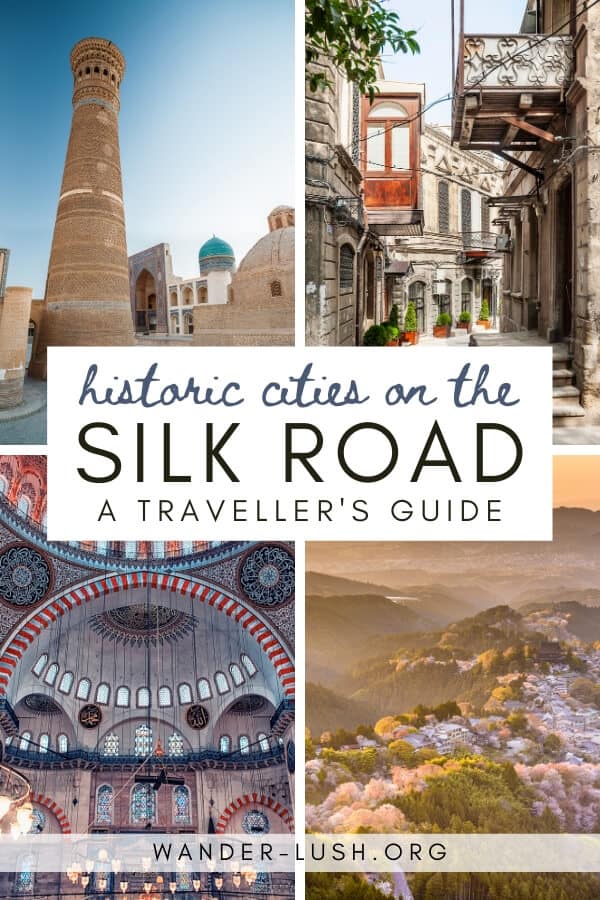
20 incredible modern-day Silk Road cities
Ground zero for the collision of two continents, the Silk Road was the main arterial for ferrying goods between Asia and Europe – including, most famously, silk.
This was the original information highway; a means by which ideas could permeate otherwise impenetrable mountain passes, cross vast deserts and navigate treacherous steppes. Along with earthly goods, knowledge, philosophy and religion also coursed along the Silk Road, harnessed to the backs of merchant camels and tucked away in pilgrims’ rucksacks. No thoroughfare has played a more important role in shaping the world as we know it than the Silk Road.
As traders carved their paths across Central Asia, they set down roots for a string of cities and towns along the way. Endowed with great bazaars, caravanserais and anything else a Silk Road trader could want or need, each of these outposts grew to embody the essence of the trading route.
Today, they carry on that legacy for us modern travellers to enjoy.
1. Istanbul, Turkey
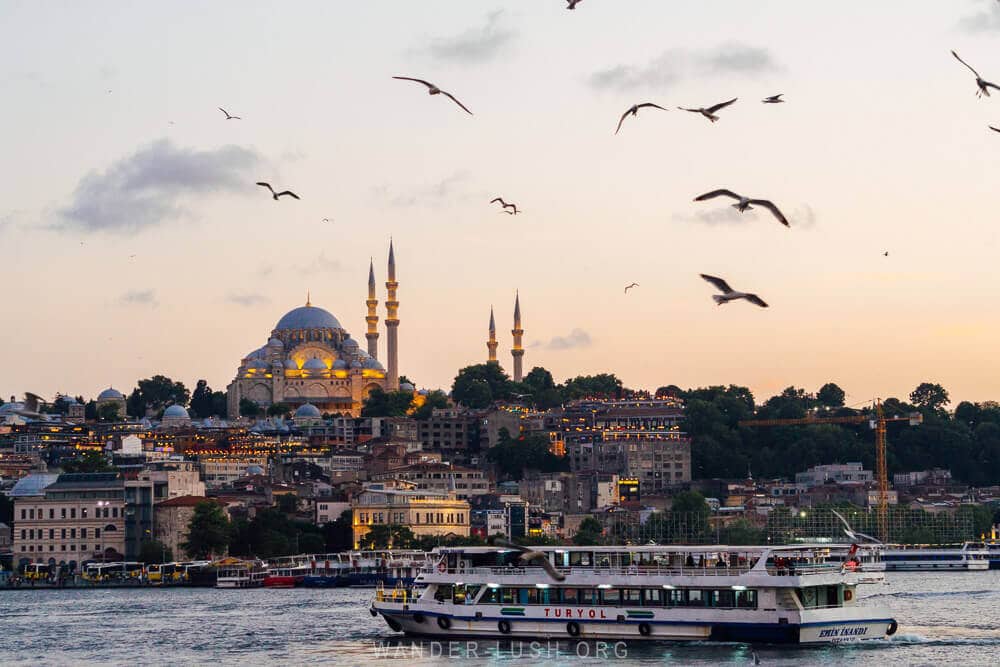
The single most important city on the Silk Road was its final terminus: Istanbul (Constantinople). It was here that traders wound up their westward journey before their goods were spirited deeper into Europe, to the marketplaces of Venice and Rome.
From the 4th century onwards, all ancient roads led to Constantinople. Almost everything you see in Turkey’s biggest city today has some connection to that time of great financial and intellectual prosperity, when the city profited from its prime location on the cusp of two continents. Christianity emanated from the cloisters of the 6th century Hagia Sophia and started its march east with Constantinople as its origin point. The Bosphorus Strait took on its persona as a lively hub for sea trade.
When it fell to the Ottomans in 1453, the city’s name was changed, but its new rulers made sure its reputation as a trading centre was still cultivated. The Grand Bazaar was established to centralise goods and still dominates Istanbul’s centre to this day.
A walk through the alleys of the Spice Bazaar and the halls of the Grand Bazaar is a highlight of any visit to Istanbul. Stop for a Turkish coffee, one of Istanbul’s most beloved traditions, before picking up a few authentic souvenirs.
2. Tbilisi, Georgia
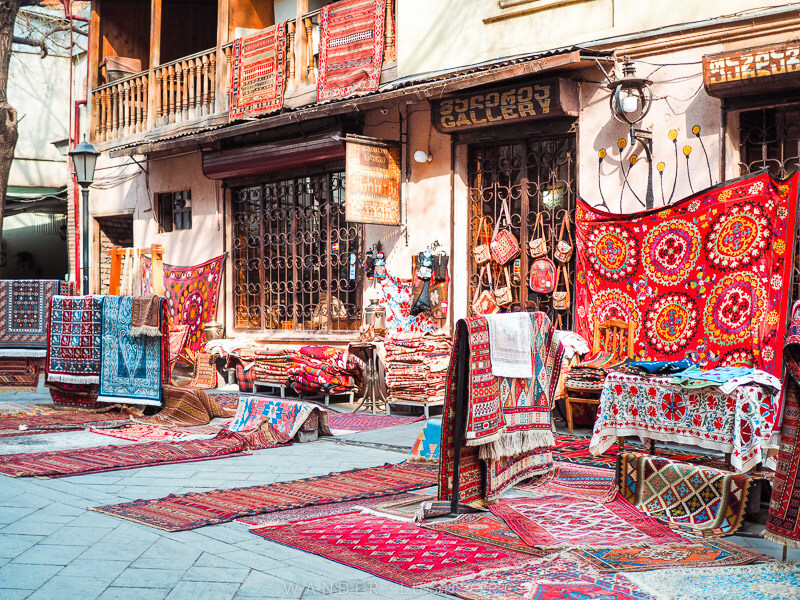
Georgia has always enjoyed a position at the geographic and conceptual crossroads of Europe and Asia, but it wasn’t until relatively late – around the 6th century – that Tbilisi became a fixture on the Silk Road. Around this time, conflict started brewing between Byzantium and Iran, necessitating the development of a new trading route that bypassed the Mediterranean.
The first caravans loaded with Chinese silk passed through Georgia in the 560s, tracking their way from the Caspian coast through the west of the country towards Constantinople. Tbilisi flourished as a trading point.
You can detect hints of Tbilisi’s Silk Road past in the crumbling mansion houses built by merchants who made their riches on successive trade routes and in the carpet shops that overflow with colourful textiles. The Meidan Bazaar, Tbilisi’s undercover marketplace, harks back to this period in time while the Dezerter Bazaar and the Dry Bridge Market – although established much, much later – echo the animated trade atmosphere Tbilisi was known for.
Anyone interested in investigating this epoch should visit the State Silk Museum, a grand (and slightly mothball) institution in Tbilisi’s Tsereteli neighbourhood. It’s wholly dedicated to documenting Georgia’s history of silk cultivation and displays a monumental collection of cocoons and silk-related study materials collected from around the world. Georgia’s climate, perfect for cultivating mulberry trees, made it the epicentre of sericulture under the Soviet Union.
3. Sheki, Azerbaijan
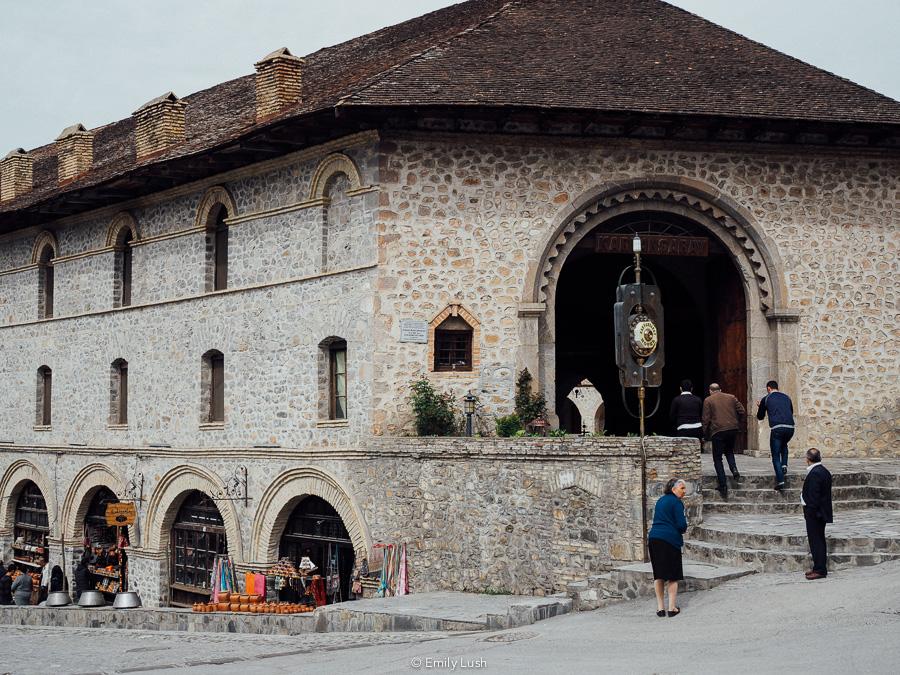
Sheki is Azerbaijan’s most charming and atmospheric city, thanks in no small part to its connection with the region’s Silk Route heritage.
Sheki is best-known for its twin Khan’s Palaces, summer and winter residences built for the region’s ruling family in the 18th century. These, along with Sheki’s citadel, were recently recognised by UNESCO for their value to cultural heritage.
Around the same time as Sheki’s skilled craftspeople were working on the palaces, fashioning shebeki window panes using coloured glass from Burano, carving ornate window frames and painting the interiors with detailed miniatures, the city started hosting traders from far-flung places.
A new tributary of the Silk Road that passed directly through Sheki made the city an important rest stop, transforming Sheki’s urban landscape in the process.
A huge caravanserai was constructed to accommodate overnight guests and their livestock. It’s still operational today, serving as a basic hotel with a beautiful green courtyard at its centre, and shops and restaurants on its lower levels. Craft workshops and a Soviet-era silk factory also speak to Sheki’s past.
The religious philosophies that moved along the Silk Road had a huge impact on Sheki. Albanian churches, some of the first in the region, popped up here as Christianity started to spread east. Visitors can see one such church in the village of Kis just outside Sheki.
4. Samarkand, Uzbekistan

Samarkand is the most popular destination in Uzbekistan and one of the most iconic stops on the Silk Route. It’s also one of the oldest continuously inhabited cities in the world, dating back to the 6th century BC. The real development of the city happened during the Silk Road time, when Samarkand was the largest city in Central Asia.
Today you can admire numerous monuments from that period. The most important is, of course, Registan, a complex of three madrases – the oldest one completed in 1420. The architecture and decorations are stunning and will surely take your breath away. Be sure to visit early in the morning to avoid the crowds. While you’re there, don’t skip Gur-e-Amir, the mausoleum dedicated to the conqueror of Central Asia, Amir Timur (known also as Tamerlane).
Another beautiful place you should see in Samarkand is Bibi-Khanym Mosque. Built in the 15th century as a gift from Amir Timur to his wife, it was counted among the most impressive mosques in the world. The last important place in Samarkand is Shah-i-Zinda, a cemetery with beautiful mausoleums, some of them from as far back as the 9th century.
There are plenty of accommodation options in Samarkand, but you should choose a place close to all the attractions. Visit local restaurants to try delicious Uzbek food, itself reason enough to visit Uzbekistan.
By Kami from Kami & the Rest of the World
5. Shiraz, Iran

Shiraz was once the capital of Persia and as one of the biggest cities south of the Zagros mountains, an important place on the ancient Silk Road. Trade caravans passed through Shiraz on their way to and from the Persian Gulf.
Known as the city of flowers, Shiraz has always been a beauty, but had its share of misfortunes as well. In its long history, it was damaged by earthquakes and Mongol invasions. Most of what we see today comes from the 18th century Zand dynasty, when Shiraz developed into a true multicultural city with markets, gardens, palaces, wealthy merchant houses, mosques and madrassas.
Walking through the ancient Vakil Bazaar still gives you that ‘Silk Road feeling’. The city is full of beautiful Islamic architecture – from the lush and symmetrical Eram gardens to the colourful pink mosque, and the visually appealing Vakil hammam.
Another Silk Road experience is dining at the Saray-e-mer tea house in the heart of the Vakil Bazaar. This restaurant not only serves tea, but also traditional Persian dishes such as eggplant stew and chicken in walnut and pomegranate sauce. The interior is like a journey back in time, when places like this catered to hundreds of merchants from all over the world every day.
By Ellis from Backpack Adventures
6. Dunhuang, China

Dunhuang, a city in Gansu province of northwestern China, was one of the most important stops on the Silk Road. It was a major trade centre and military outpost during the Sui and Tang dynasties (581-907).
When Buddhism reached China via the Silk Road, Dunhuang was the first stop for monks arriving from the west. They built the Mogao Caves (also known as the ‘Caves of a Thousand Buddhas’) for meditations, pilgrimage and worship. Today, Mogao Caves famously holds the world’s largest collection of Buddhist art, including murals, sculptures, artefacts, printed images, textiles, and cave art.
Another notable sight is Yumen Pass (also known as Jade Gate). Located at the west of Dunhuang, Yumen Pass was an important gateway for the ancient Silk Road. Nature lovers should not miss Yadan National Geological Park, a collection of rock formations in the Yadan desert that’s said to be over 700,000 years old.
For an unforgettable gastronomic experience in Dunhuang, visit Shazhou Night Market on Yangguan Road. It’s the perfect place for tourists to sample local delicacies and fruit. The top must-try foods are donkey meat with yellow noodles, apricot peel water, lamb noodle soup, and dried fruits (raisins, dried Goji, and dried apricot).
Finally, Dunhuang is very popular among domestic travellers. It’s advisable to avoid visiting Dunhuang (or China in general) during Golden Week and the summer holiday. Instead, the best time to visit Dunhuang is May through June, and September through October, when the weather is agreeable and there are no annoying crowds.
By Ming from Flyerism
7. Karimabad, Pakistan

Sheltered by a barrage of high mountains that encapsulate it like a rare diamond, Karimabad, the main settlement in the Hunza Valley of Pakistan, probably still looks much as it did when it was an important stop along the Southern Silk Road between China and the Indian Subcontinent.
Set along the stunning Karakoram Highway that connects Islamabad to Kashgar in China’s Xinjiang province, Karimabad has developed into a tourist hotspot.
It couldn’t not have – Karimabad is nearby Ultar Peak (7388m) and its glacier, and set above the ancient village of Ganesh, with its ancient wooden mosque and traditional homes. Watched over by mount Rakaposhi (7788m) and Diran (7270m), Karimabad is as beautiful as it is peaceful. There’s no better way to soak up the scenery than by driving up to the Eagle’s Nest viewpoint at sunset.
The Altit and Baltit forts, two of Pakistan’s UNESCO World Heritage Sites, have protected the two opposite sides of Karimabad for 800 years, and are the perfect places to start discovering the town’s Silk Road heritage. Start by exploring the small passageways within the forts that lead up to open roofs and turrets perched above deep gorges and ravines.
Then it’s time to experience the modern face of Karimabad. Cafe de Hunza is an unmissable bakery where you must try the valley’s famous walnut cakes and apricot jams. All this while you sip on real espresso and surf the web on Hunza’s fastest WIFI!
Karimabad’s central strip is lined with all the small cafes, restaurants, pizzerias and guesthouses you can expect from a tourist town – remember that you won’t get the same level of facilities anywhere else on Pakistan’s Karakoram Highway, so enjoy all of it while it lasts.
Serena Inn Hunza, one of Pakistan’s best boutique hotels, is the most expensive and atmospheric choice in town, and it will throw you back to a caravanserai atmosphere. Highly recommended for a stylish stay.
By Marco from Monkey Rock World
8. Baku, Azerbaijan
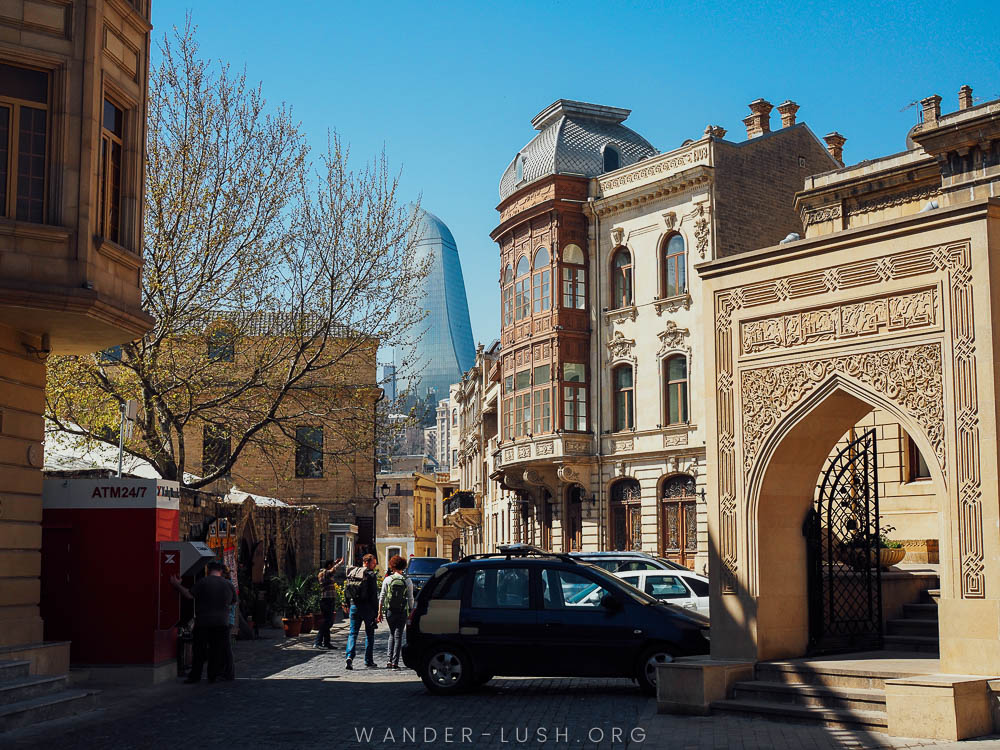
Much of modern-day Baku‘s skyline has been shaped by the country’s oil wealth. As black gold started flowing in the Land of Fire, silk and other goods that flooded in via the Silk Road added to the city’s prosperity.
Baku sits on the Caspian Sea and was the main port that received goods from Central Asia, a maritime iteration of the Silk Road. The city still revolves around the seafront, with the massive Bulvar boulevard wrapped around its coast.
The Icherisheher (‘Inner City’) is home to many of Baku’s must-see monuments, including the Maiden Tower. This edifice has a connection to Zoroastrianism, a transformative religious force that wielded great influence along the Silk Road and had strong roots in Baku.
A number of Silk Road-era relics can also be found inside the Old City: caravanserais, hammams, madrassas, tea shops, and more.
9. Almaty, Kazakhstan

Almaty is another of the historic epicentres of the Silk Road. The country of Kazakhstan is heavily investing in reviving places related to this chapter of history. Their goal is to increase Silk Road tourism and make the road more accessible to visitors.
One complication that the country is facing is that the nature of the Silk Road, which served as a connector between different cities, means that there aren’t many physical sites left from the period.
One place you can visit as a day trip from Almaty is Tamgaly Tas, a Buddhist Rock Art Sanctuary. The petroglyphs here were created by Buddhist monks and are a great reminder of Almaty’s role on the East-West corridor. You can also see yurts here and you can visit Nomad’s Land, a former movie set turned tourist site.
While in Almaty, make sure to see Big Almaty Lake outside of the city, as well as other Almaty highlights like Zenkov’s Cathedral. This is also a great place for Red Tourism. Make sure to visit the memorial to the victims of the Kazakh Famine, which was as devastating to Kazakhstan as the famine in Ukraine was. You can also stay in a former Soviet Hotel, the Kazakhstan Hotel.
By Stephanie from History Fangirl
10. Bishkek, Kyrgyzstan

Bishkek is an eclectic mix of its Silk Road past, nomadic Kyrgyz influence, and Soviet-era relics. The city doesn’t ooze charm in the way many tourist destinations do – but if you look a little deeper, there are plenty of quirky and interesting things to see and do around the city.
There are the main attractions such as Ala-Too Square, which boasts large concrete buildings and the token Lenin statue of most post-Soviet cities. One of the buildings houses the State History Museum which illustrates all eras of Kyrgyzstan’s past.
For those wanting a throwback to the Silk Road times, head to the Osh bazaar where you’ll find everything from souvenir stands to food, traditional dress to instruments, and everything in between. The low numbers of foreign tourists in Kyrgyzstan mean that visiting the market is still an authentic experience. You’ll have to dodge your way through crowds of men in kalpaks (traditional hats) and people spruiking their wares.
With such a rich history, Bishkek has done well to keep up with the times and also offers visitors a great cafe, restaurant and craft beer scene. Tucked in corners around the city you can find delicious traditional cuisine (try Navat) as well as popular Western options.
For great craft beer and food from the restaurant next door, head to Save the Ales, a female-run brewery which employs lesbian women who struggle to find work elsewhere due to Kyrgyzstan’s conservative attitude towards the LGBT community.
By Rohan from Travels of a Bookpacker
11. Bhaktapur, Nepal

Bhaktapur is known as Nepal’s cultural capital. If you’re a keen cultural observer, you must stay here for at least a couple of nights in order to trace back all the invisible links to the ancient Silk Route that connected a vast part of Asia.
Bhaktapur rose from the rubble of the 2015 Gorkha earthquake, but unfortunately the natural disaster claimed most of the remnants of her glorious past. Back then, tradesmen trod all the way from the coast of the Andaman sea, braved the Himalayas, and walked still further. Bhaktapur was one of their pit stops, and the town benefited substantially as a strategically important link on the Silk Road.
Every stone of Bhaktapur bears some kind of religious semblance. The city’s intricately carved windows and art testify to Bhaktapur’s rich heritage. Each of its temple is rich with Newari architecture and styled with a pagoda as its top, various pillars and staircases. The most famous temples of Bhaktapur are Dattatryara, Nyataponla (the contemporary of the Taj Mahal), Pashupatinath, and the most important of all, Taleju Bhabani. Only Hindus are allowed inside the latter temple complex, however anyone can see the stunning golden gates.
Apart from traditional Newari cuisine, must-eats in Bhaktapur include Juju Dhau, curd with a crunchy layer on top. Black clay pottery is a famous handicraft from Bhaktapur and you must visit the local village where this art is practiced.
Dress modestly, and be aware that Hindu religious involving animal sacrifice are common practice (during a half day tour of Bhaktapur, I came across at least two sites where an animal was sacrificed).
By Madhurima from Orange Wayfarer
12. Ulaanbaatar, Mongolia

Ulaanbaatar is one of those cities where what you see isn’t exactly what you get.
Everyone knows (or thinks they know) the stories and legends surrounding the country’s most regaled ruler/warrior (you know the one), but it isn’t until you see the 40-metre tall Chinggis Khaan Equestrian Statue, or visit the city’s National History Museum, or hear locals speak about the Great Khaan and everything he once accomplished and how he shaped the modern world today, that you start to understand who the man behind the legend actually was, for better or worse.
(You also won’t be able to escape his image in the city – from being the face on local currency, to adorning vodka bottles, and sitting guard in front of the capital’s parliament building – he still watches over Mongolia and it’s people with a watchful eye, more than 800 years later.)
Once ruler of half the world, and an important overseer of the development of the Silk Road route, Ulaanbaatar and the ancient capital city of Kharkhorin, and the surrounding countryside, are still home to nomads and thousands of years of traditions.
Mongolia is sometimes reminiscent of a land that time forgot. It’s a truly surreal experience to live like this – drinking airag, herding horses, living life in a ger – even just for a few days, putting into perspective what life in the 13th century must have been like.
By Breanna from Meanwhile… in Mongolia
13. Xi’an, China

No list of Silk Road cities is complete without the Eastern departure point, often dubbed the ‘start’ of the Silk Road: Xi’an. This Chinese city has a rich history stretching back to the Zhou dynasty in the 11th century BC; but it’s the confluence of cultures about 1,000 years ago during the Western Han dynasty that truly put Xi’an on the map.
A noted trading post and hub for merchants in China, Xi’An saw silk, ceramics and spice traders from Arabia and Persia flock to the city, most of them settling in what is now known as the ‘Muslim Quarter’. The Quarter is a must-see for anyone visiting this captivating city, not just to explore the ancient attractions of the Hanguang Gate, the City God Temple and the Grand Mosque, but also to tuck into the unique dishes, where meat-lovers will delight in beefy steamed sandwiches and local delicacies like pao mo, a bread and mutton soup.
Silk Road adventure seekers should also spend a few hours walking the old city walls – claimed to be the largest in the world. The 14km loop was constructed to protect the city from invaders and is the oldest military defensive system on the planet, now best enjoyed on a very long walk or by meandering along on one of the bicycles available for rent.
You can’t go to Xi’an without visiting the legendary Terracotta Warriors, of course, as well as climbing the beautiful Bell and Drum Towers, soaring structures built to signal the start and end of the working day.
By Lee from The Travel Scribes
14. Bukhara, Uzbekistan

Bukhara is another of the most popular tourist destinations in Uzbekistan. In medieval times, the city was one of the main stops on the Silk Road and specialised in the trading of carpets. It was also a cultural and religious centre.
Bukhara has around 140 monuments, so visitors are spoiled for choice. The best thing to do in Bukhara is wander around the historical centre with no particular destination in mind. This place still witnesses trading and is home to many remnants of the country’s glorious past, boasting magnificent mosques, madrassas, and other monuments.
People interested in the Silk Route shouldn’t miss the three main bazaars, where people buy and sell just as they did in Silk Road times. A visit to a rug shop is an interesting experience. A stop at the UNESCO Carpet Weaving Shop is highly recommended.
Make time to visit at least one religious complex to admire the monumental architecture decorated with blue tiles so typical of Central Asia. The Mosque Kalon or Friday Mosque is a good example of this kind of design. It’s one of the oldest mosques in the city (8th century) and also the biggest, with a capacity of more than 10,000 worshippers.
During the hottest hours of the day, look for a shady cafe to sip a mint tea. This drink is very typical of Bukhara – and Uzbekistan in general – plus it’s a good opportunity to meet the locals.
By Elisa from World in Paris
15. Nara, Japan

Nara was the eastern end of the Silk Road and was also the capital of Japan from 710 AD to 794 AD. It was not just silk but also religion that spread along the Silk Route, and Nara became an important religious centre for followers of Shintoism as well as Buddhism.
The city’s most impressive man-made site is the Great Buddha statue (Daibutsu in Japanese). This gigantic bronze edifice sits inside the Todai-ji Temple, which still today is the largest wooden building in the world.
This temple, along with an important Shinto shrine and several other historical and religious monuments, are all contained within the very green Nara Park. In addition to its monuments, the park is most famous for the semi-tame deer who live there.
Most people visit Nara as a day trip from Kyoto or Osaka, but it’s definitely worth spending at least one night. That way, you can enjoy the peace and quiet of the park before the hordes of tourists arrive, and you can see the spectacular sunset from Nigatsu-do, a sub-temple of Todai-ji.
Ramuna Cafe makes a convenient lunch stop as it’s near all the main sights. It’s one of several restaurants that offer delicious vegan food in Nara. Hiloki Hostel is a solid budget accommodation option, offering dorms as well as private rooms.
By Wendy from The Nomadic Vegan
16. Gyeongju, South Korea

Located on the south-east coast of South Korea, Gyeongju is a must for your Korea bucket list. This city is known for its fascinating history, acting as the capital of the Silla dynasty for almost a millennium, which flourished from BC 57 to AD 935 under the rule of 56 different kings.
In the 7th century, Gyeongju became the main trading port on the Korean Peninsula, greeting merchants who came by both land and sea from China, Japan and the Arabian Peninsula via the Silk Road. Over time, the different influences and ideas they brought with them permeated local culture, turning Gyeongju into a dynamic cultural hub.
For history lovers, there are few better stops in Korea than Gyeongju, which is often called the ‘museum without walls’. Morbid as it may sound, one of the best things to do is wander Tumuli Park where a collection of man-made pyramids house the remains of the kings, many found buried with decadent gold, jewels, and the bones of their servants who would have been buried alive with them, apparently the ultimate honour!
Other things to do in Gyeongju include visiting Bulguksa Temple, which dates back to 528, and hiking up to Seokguram Grotto just above it, home to a 1,000-year-old Buddha statue. You’ll need to catch a bus to these two attractions; on the way back, stop off at Gyeongju National Museum to learn about the Silla Dynasty.
You shouldn’t miss the oldest astronomical observatory in East Asia, Cheomseongdae Observatory Tower, located close to Donggung Palace and Wolji Pond, a colourful palace complex that’s also worth exploring.
By Rose from Where Goes Rose
17. Jaisalmer, India

Jaisalmer rises straight up out of the flat sands of the Rajasthani desert like a fantasy from the Arabian nights. A sandstone fortress that sits atop a rocky outcrop in the middle of the desert, this is India’s famed Golden City. Seeing Jaisalmer from afar at twilight, when it glows in the light of late afternoon, is a breathtaking experience that you will never forget.
Built in the 12th century, Jaisalmer was a major stopover on the southern tributary of the Silk Route. It’s possible to recreate the old Silk Road experience today in several ways. Modern-day travellers can imagine what it was like to be a merchant by taking an overnight or multi-day camel safari into the nearby That Desert, visiting tiny tribal villages and sleeping on sand dunes under the stars. There are many travel agencies in town that can arrange these trips.
Or step back in time exploring Jaisalmer Fort. The fort, which dominates the town, is a living city, and gives travellers a real sense of what life was like back in the old Silk Road days. There are several hotels inside the fort itself, as well as many nearby hotels with views of the fort.
Jaisalmer is home to many ornate Jain temples that date from between the 12th and 16th centuries, as well as many incredible havelis (merchant houses). The best havelis ones are covered in incredibly elaborate carvings. Many of the smaller houses have been converted into comfortable guesthouses that are full of character and mystical charm.
Jaisalmer is an absolute must-stop on every Silk Road trip (and every journey to India!)
By James Ian from Travel Collecting
18. Leh, India

Leh is a beautiful Indian town situated in Ladakh in the heart of the Himalayas. During Silk Road times, it was an outpost on the mountain pass that connected India with Tibet to the east and Kashmir and the Karakoram mountains to the north and west – a vital route for trading much-sought-after pashmina wool.
Salt, cotton, silk and spices flowed along this route until as recently as the 1940s, with Leh serving as the Western Himalayas’ main marketplace for the exchange of goods between India and Tibet.
The landscape around Leh is diverse and there are many stunning places for nature lovers to explore. Nubra Valley, Pangong Lake and Khardung La Pass are unmissable. While in Leh city, be sure to visit the famous Shanti Stupa and the Leh Palace. The bustling Leh Main Bazaar is a hive of activity and another must-see for anyone interested in Silk Route heritage.
Be sure to try the local food as well. Thukpa is an exceptionally tasty noodle soup that is typical to the town. Tibetan-style dumplings are a must-try. Kashmiri cuisine, including yakhni (mutton with yogurt and saffron), is a testament to the exchange of recipes and spices along the Silk Road.
The helpful and kind people of Leh make visiting this town even more special.
By Merryl from Merryl’s Travel and Tricks
19. Yazd, Iran

Yazd, a charming city in the south of Iran, is one of the most interesting places to visit in the country. Together with the smaller cities of Kashan, Nain and Kerman, the Silk Road crossed Yazd on its way through southern Iran.
Yazd was famous for its silk and carpet production, and the centre of the town during its Silk Road heyday was the bazaar, which remains a hub to this day. Caravanserais, mosques, bathhouses, schools and other infrastructure were built in the vicinity.
The old part of Yazd is a labyrinth of mud houses with typical wind chimneys called badgir. A unique water pipe system called qanat provided much-needed water from the mountains and contributed to the prosperity of Yazd and its textile production.
A large caravanserai can be visited on the outskirts of a village called Kharanaq, about an hourlong drive from Yazd. Visitors can also admire Yazd’s Zoroastrian sights, since the town has always been home to a large Zoroastrian community, the dominant religion before Persia’s turn to Islam.
Yazd shouldn’t be missed – it’s recommended to visit as part of a two week Iran itinerary.
By Veronika from Travel Geekery
20. Yerevan, Armenia
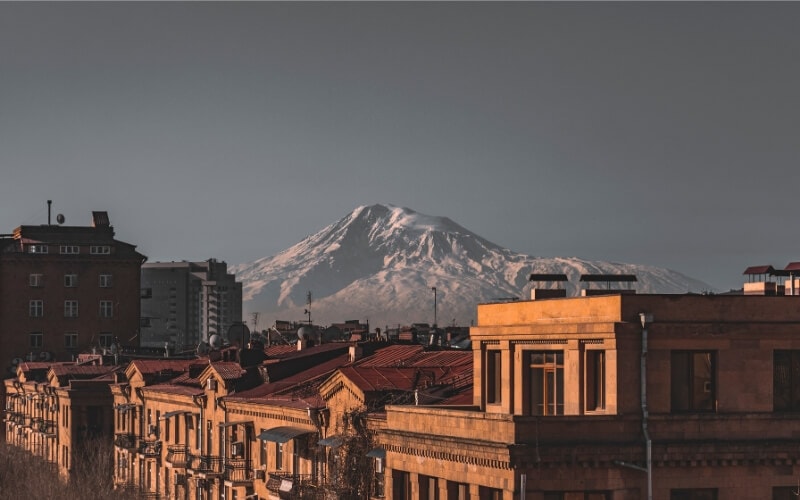
Armenia isn’t always associated with the Silk Road, but because of its location, caravans couldn’t help but pass through the Caucasus nation as they crisscrossed from east to west via the Ararat valley. Yerevan and other Armenian cities benefited from the exchange of goods and ideas just as much as more established outposts in Central Asia did.
More than being conveniently positioned, Armenia was always looked on as a land of infinite cultural and artistic riches. Armenian wine, dyes, carpets – and even horses – were exported to Babylon and Persia from as early as the 5th century BC. Merchants naturally gravitated towards Armenia’s craft workshops and marketplaces when looking for new objects to buy and sell.
Yerevan’s history reaches far further back than its Silk Road days, yet reminders of this time can be felt everywhere, from the sprawling Vernissage Market where modern-day artisans ply their trades, crafting beautiful woodwork, textiles and souvenirs, to the Tufenkian Historic Hotel where fine Armenian carpets are displayed.
It’s also interesting to note the ways Armenia resisted the influence of the Silk Route – the globalisation force of its time. The first state to adopt Christianity as its religion, its many churches, including the oldest in Yerevan, Katoghike Church, are a testament to how this country held onto its religious and cultural convictions in the face of great change.

Very nice! I was in Thailand and Indonesia just before the pandemic started. I didn’t make it to Australia. Perhaps next time.